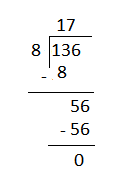This handy Spectrum Math Grade 4 Answer Key Chapter 5 Posttest provides detailed answers for the workbook questions.
Spectrum Math Grade 4 Chapter 5 Posttest Answers Key
Check What Your Learned
Divide.
Question 1.
a.
![]()
Answer:
Step 1: Since the first digit of the dividend is less than the divisor, bring down the next digit of the dividend. Now consider the first 2 digits to proceed with the division.
Step 2: 18 is divisible by 3, as we know that 3 × 6 = 18 so, we go for it.
Step 3: Write 6 in the quotient.
Check:
Do the inverse operation to check your answer.
If 18 ÷ 3 = 6, then 3 × 6 = 18 must be true.
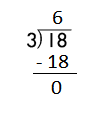
b.
![]()
Answer:
Step 1: Since the first digit of the dividend is less than the divisor, bring down the next digit of the dividend. Now consider the first 2 digits to proceed with the division.
Step 2: 27 is divisible by 3, as we know that 9 × 3 = 27 so, we go for it.
Step 3: Write 3 in the quotient.
Check:
Do the inverse operation to check your answer.
If 27 ÷ 9 = 3, then 9 × 3 = 27 must be true.

c.
![]()
Answer:
Step 1: The first digit of the dividend is is divisible by the divisor.
Step 2: 7 is divisible by 7, as we know that 7 × 1 = 7 so, we go for it.
Step 3: Write 1 in the quotient.
Check:
Do the inverse operation to check your answer.
If 7 ÷ 7 = 1, then 7 × 1 = 7 must be true.
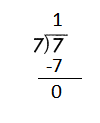
d.
![]()
Answer:
Step 1: Since the first digit of the dividend is less than the divisor, bring down the next digit of the dividend. Now consider the first 2 digits to proceed with the division.
Step 2: 64 is divisible by 8, as we know that 8 × 8 = 64 so, we go for it.
Step 3: Write 8 in the quotient.
Check:
Do the inverse operation to check your answer.
If 64 ÷ 8 = 8, then 8 × 8 = 64 must be true.
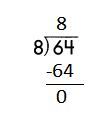
e.
![]()
Answer:
Step 1: The first digit of the dividend is is divisible by the divisor.
Step 2: 4 is divisible by 4, as we know that 4 × 1 = 4 so, we go for it.
Step 3: Write 1 in the quotient. The next digit is 0, we know that 4×0=0. So write 0 in the quotient.
Check:
Do the inverse operation to check your answer.
If 40 ÷ 4 = 10, then 4 × 10 = 40 must be true.
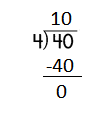
Question 2.
a.
![]()
Answer:
Step 1: Since the first digit of the dividend is less than the divisor, bring down the next digit of the dividend. Now consider the first 2 digits to proceed with the division.
Step 2: 72 is divisible by 9, as we know that 9 × 8 = 72 so, we go for it.
Step 3: Write 8 in the quotient.
Check:
Do the inverse operation to check your answer.
If 72 ÷ 9 = 8, then 9 × 8 = 72 must be true.
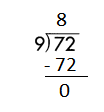
b.
![]()
Answer:
Step 1: Since the first digit of the dividend is less than the divisor, bring down the next digit of the dividend. Now consider the first 2 digits to proceed with the division.
Step 2: 36 is divisible by 6, as we know that 6 × 6 = 36 so, we go for it.
Step 3: Write 6 in the quotient.
Check:
Do the inverse operation to check your answer.
If 36 ÷ 6 = 6, then 6 × 6 = 36 must be true.
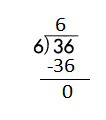
c.
![]()
Answer:
Step 1: Since the first digit of the dividend is less than the divisor, bring down the next digit of the dividend. Now consider the first 2 digits to proceed with the division.
Step 2: 16 is divisible by 8, as we know that 8 × 2 = 16 so, we go for it.
Step 3: Write 2 in the quotient.
Check:
Do the inverse operation to check your answer.
If 16 ÷ 8 = 2, then 8 × 2 = 16 must be true.
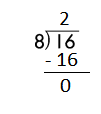
d.
![]()
Answer:
Step 1: Since the first digit of the dividend is less than the divisor, bring down the next digit of the dividend. Now consider the first 2 digits to proceed with the division.
Step 2: 21 is divisible by 7, as we know that 7 × 3 = 21 so, we go for it.
Step 3: Write 3 in the quotient.
Check:
Do the inverse operation to check your answer.
If 21 ÷ 7 = 3, then 7 × 3 = 21 must be true.
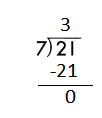
e.
![]()
Answer:
Step 1: Since the first digit of the dividend is less than the divisor, bring down the next digit of the dividend. Now consider the first 2 digits to proceed with the division.
Step 2: 28 is divisible by 4, as we know that 4 × 7 = 28 so, we go for it.
Step 3: Write 7 in the quotient.
Check:
Do the inverse operation to check your answer.
If 28 ÷ 4 = 7, then 4 × 7 = 28 must be true.
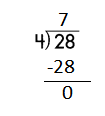
Question 3.
a.
![]()
Answer:
Step 1: Since the first digit of the dividend is less than the divisor, bring down the next digit of the dividend. Now consider the first 2 digits to proceed with the division.
Step 2: 25 is divisible by 5, as we know that 5 × 5 = 25 so, we go for it.
Step 3: Write 5 in the quotient.
Check:
Do the inverse operation to check your answer.
If 25 ÷ 5 = 5, then 5 × 5 = 25 must be true.

b.
![]()
Answer:
Step 1: Since the first digit of the dividend is less than the divisor, bring down the next digit of the dividend. Now consider the first 2 digits to proceed with the division.
Step 2: 64 is divisible by 8, as we know that 8 × 8 = 64 so, we go for it.
Step 3: Write 8 in the quotient.
Check:
Do the inverse operation to check your answer.
If 64 ÷ 8 = 8, then 8 × 8 = 64 must be true.
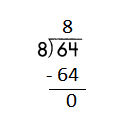
c.
![]()
Answer:
Step 1: Since the first digit of the dividend is less than the divisor, bring down the next digit of the dividend. Now consider the first 2 digits to proceed with the division.
Step 2: 54 is divisible by 9, as we know that 9 × 6 = 54 so, we go for it.
Step 3: Write 6 in the quotient.
Check:
Do the inverse operation to check your answer.
If 54 ÷ 9 = 6, then 9 × 6 = 54 must be true.
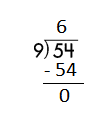
d.
![]()
Answer:
Step 1: Since the first digit of the dividend is less than the divisor, bring down the next digit of the dividend. Now consider the first 2 digits to proceed with the division.
Step 2: 35 is divisible by 5, as we know that 5 × 7 = 35 so, we go for it.
Step 3: Write 7 in the quotient.
Check:
Do the inverse operation to check your answer.
If 35 ÷ 5 = 7, then 5 × 7 = 35 must be true.
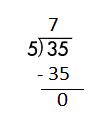
e.
![]()
Answer:
Step 1: Since the first digit of the dividend is less than the divisor, bring down the next digit of the dividend. Now consider the first 2 digits to proceed with the division.
Step 2: 12 is divisible by 3, as we know that 3 × 4 = 12 so, we go for it.
Step 3: Write 4 in the quotient.
Check:
Do the inverse operation to check your answer.
If 12 ÷ 3 = 4, then 3 × 4 = 12 must be true.
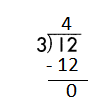
Question 4.
a.
![]()
Answer:
Step 1: Since the first digit of the dividend is less than the divisor, bring down the next digit of the dividend. Now consider the first 2 digits to proceed with the division.
Step 2: 49 is divisible by 7, as we know that 7 × 7 = 49 so, we go for it.
Step 3: Write 7 in the quotient.
Check:
Do the inverse operation to check your answer.
If 49 ÷ 7 = 7, then 7 × 7 = 49 must be true.
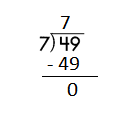
b.
![]()
Answer:
Step 1: The first digit of the dividend is is divisible by the divisor.
Step 2: 9 is divisible by 9, as we know that 9 × 1 = 9 so, we go for it.
Step 3: Write 9 in the quotient.
Check:
Do the inverse operation to check your answer.
If 9 ÷ 9 = 1, then 9 × 1 = 9 must be true.

c.
![]()
Answer:
Step 1: Since the first digit of the dividend is less than the divisor, bring down the next digit of the dividend. Now consider the first 2 digits to proceed with the division.
Step 2: 21 is divisible by 7, as we know that 7 × 3 = 21 so, we go for it.
Step 3: Write 3 in the quotient.
Check:
Do the inverse operation to check your answer.
If 21 ÷ 7 = 3, then 7 × 3 = 21 must be true.
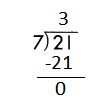
d.
![]()
Answer:
Step 1: Since the first digit of the dividend is less than the divisor, bring down the next digit of the dividend. Now consider the first 2 digits to proceed with the division.
Step 2: 18 is divisible by 2, as we know that 2 × 9 = 18 so, we go for it.
Step 3: Write 9 in the quotient.
Check:
Do the inverse operation to check your answer.
If 18 ÷ 2 = 9, then 2 × 9 = 18 must be true.

e.
![]()
Answer:
Step 1: Since the first digit of the dividend is less than the divisor, bring down the next digit of the dividend. Now consider the first 2 digits to proceed with the division.
Step 2: 18 is divisible by 3, as we know that 3 × 6 = 18 so, we go for it.
Step 3: Write 6 in the quotient.
Check:
Do the inverse operation to check your answer.
If 18 ÷ 3 = 6, then 3 × 6 = 18 must be true.
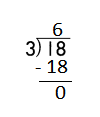
Question 5.
a.
![]()
Answer:
Step 1: Here, the first digit of the dividend is 9 and it is greater to the divisor. We know that 2 × 4 = 8. so, we go for it. So, 4 is written on top as the first digit of the quotient.
Step 2: Subtract 9 – 8 = 1. Bring the second digit of the dividend down. Now the dividend will be 16.
Step 3: 16 is divisible by 2. We know that 2 × 8 = 16. so, we go for it.
Step 4: Subtract 16 – 16 = 0. Write 8 in the quotient.
Step 5: Thus, 0 is the remainder and 48 is the quotient.

b.
![]()
Answer:
Step 1: Here, the first digit of the dividend is 8 and it is greater to the divisor. We know that 3 × 2 = 6. so, we go for it. So, 2 is written on top as the first digit of the quotient.
Step 2: Subtract 8 – 6 = 2. Bring the second digit of the dividend down. Now the dividend will be 27.
Step 3: 27 is divisible by 3. We know that 3 × 9 = 27. So, we go for it.
Step 4: Subtract 27 – 27 = 0. Write 9 in the quotient.
Step 5: Thus, 0 is the remainder and 29 is the quotient.
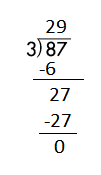
c.
![]()
Answer:
Step 1: Here, the first digit of the dividend is 9 and it is greater to the divisor. We know that 8 × 1 = 8. so, we go for it. So, 1 is written on top as the first digit of the quotient.
Step 2: Subtract 9 – 8 = 1. Bring the second digit of the dividend down. Now the dividend will be 13.
Step 3: We know that 8 × 1 = 8. so, we go for it.
Step 4: Subtract 13 – 8 = 5. Write 1 in the quotient.
Step 5: Thus, 5 is the remainder and 11 is the quotient.

d.
![]()
Answer:
Step 1: Consider the two digits of the dividend. 30 is divisible by 30, we know that 30×1=30.
Step 2: Write 1 in the quotient. Bring the second digit of the dividend down which is 0.
Step 3: We know that 30×0 = 0. Write 0 in the quotient.
Step 4: Thus 0 is the remainder and 10 is the quotient.
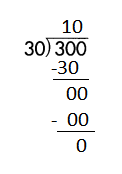
e.
![]()
Answer:
Step 1: Since the first digit of the dividend is less than the divisor, bring down the next digit of the dividend. Now consider the first 2 digits to proceed with the division.
Step 2: We know that 7 × 4 = 28 so, we go for it. Subtract 31 – 28 = 3.
Step 3: Write 4 in the quotient and 3 in the remainder.
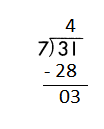
Question 6.
a.
![]()
Answer:
Step 1: Since the first digit of the dividend is less than the divisor, bring down the next digit of the dividend. Now consider the first 2 digits to proceed with the division.
Step 2: We know that 8 × 9 = 72 so, we go for it. Subtract 75 – 72 = 3.
Step 3: Write 9 in the quotient and 3 in the remainder.

b.
![]()
Answer:
Step 1: Since the first digit of the dividend is less than the divisor, bring down the next digit of the dividend. Now consider the first 2 digits to proceed with the division.
Step 2: We know that 2 × 9 = 18 so, we go for it. Subtract 19 – 18 = 1.
Step 3: Write 9 in the quotient and 1 in the remainder.

c.
![]()
Answer:
Step 1: Since the first digit of the dividend is less than the divisor, bring down the next digit of the dividend. Now consider the first 2 digits to proceed with the division.
Step 2: We know that 8 × 5 = 40 so, we go for it. Subtract 43 – 40 = 3.
Step 3: Write 5 in the quotient and 3 in the remainder.
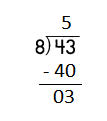
d.
![]()
Answer:
Step 1: Since the first digit of the dividend is less than the divisor, bring down the next digit of the dividend. Now consider the first 2 digits to proceed with the division.
Step 2: We know that 9 × 9 = 81 so, we go for it. Subtract 89 – 81 = 8.
Step 3: Write 9 in the quotient and 8 in the remainder.
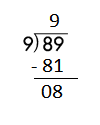
e.
![]()
Answer:
Step 1: Here, the first digit of the dividend is 6 and it is greater to the divisor. We know that 3 × 2 = 6. so, we go for it. So, 2 is written on top as the first digit of the quotient.
Step 2: Subtract 6 – 6 = 0. Bring the second digit of the dividend down. Now the dividend will be 6.
Step 3: 6 is divisible by 3. We know that 3 × 2 = 6. so, we go for it.
Step 4: Subtract 6 – 6 = 0. Write 2 in the quotient.
Step 5: Thus, 0 is the remainder and 22 is the quotient.
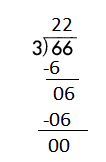
Question 7.
a.
![]()
Answer:
Step 1:Here, the first digit of the dividend is 9 and it is greater to the divisor. We know that 3 × 2 = 6. so, we go for it. So, 2 is written on top as the first digit of the quotient.
Step 2: Bring down the next digit, 1 is less than 3. Write 0 in the quotient and bring down the next digit. Now the dividend will be 11. We know that 3 × 3 = 9 so, we go for it. Subtract 11 – 9 = 2. Write 3 in the quotient.
Step 3: Now the dividend will be 28. We know that 3 × 9 = 27 so, we go for it. Subtract 28 – 27 = 1. Write 9 in the quotient.
Step 4: Now the quotient is 2039 and remainder is 1.
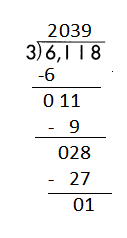
b.
![]()
Answer:
Step 1:Here, the first digit of the dividend is 9 and it is greater to the divisor. We know that 5 × 1 = 5. so, we go for it. So, 1 is written on top as the first digit of the quotient.
Step 2: Subtract 9 – 5 = 4. Now the dividend will be 41. We know that 5 × 8 = 40 so, we go for it. Subtract 41 – 40 = 1. Write 8 in the quotient.
Step 3: Now the dividend will be 17. We know that 5 × 3 = 15 so, we go for it. Subtract 17 – 15 = 2. Write 3 in the quotient.
Step 4: Now the quotient is 183 and remainder is 2.
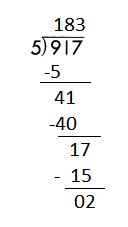
c.
![]()
Answer:
Step 1:Here, the first digit of the dividend is 7 and it is greater to the divisor. We know that 6 × 1 = 6. so, we go for it. So, 1 is written on top as the first digit of the quotient.
Step 2: Now the dividend will be 16. We know that 6 × 2 = 12 so, we go for it. Subtract 16 – 12 = 4. Write 2 in the quotient.
Step 3: Now the dividend will be 42. It is divisible by 6. We know that 6 × 7 = 42 so, we go for it. Subtract 42 – 42 = 0. Write 7 in the quotient.
Step 4: Now the quotient is 127 and remainder is 0.
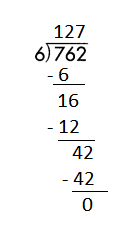
d.
![]()
Answer:
Step 1: Since the first digit of the dividend is less than the divisor, bring down the next digit of the dividend. Now consider the first 2 digits to proceed with the division.
Step 2: We know that 7 × 5 = 35 so, we go for it. Subtract 37 – 35 = 2.
Step 3: Write 5 in the quotient and 2 in the remainder.

e.
![]()
Answer:
Step 1: Here, the first digit of the dividend is 4 and it is greater to the divisor. We know that 2 × 2 = 4. so, we go for it. So, 2 is written on top as the first digit of the quotient.
Step 2: Subtract 4 – 4 = 0. Bring the second digit of the dividend down. Now the dividend will be 8.
Step 3: 8 is divisible by 2. We know that 2 × 4 = 8. so, we go for it.
Step 4: Subtract 8 – 8 = 0. Write 4 in the quotient.
Step 5: Thus, 0 is the remainder and 24 is the quotient.
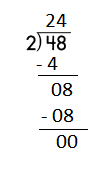
Solve each problem. Show your work.
Question 8.
A group of 7 boys cut lawns over the weekend. They made 56 dollars. Each boy will make the same amount. How much money will each boy get?
Each boy will get __________ dollars.
Answer:
Given that a group of 7 boys cut lawns over the weekend. They made 56 dollars and each of them made same amount.
To get the amount, divide 56 by 7 which gives 8 as the quotient and 0 as the remainder.
Thus, each boy will get 8 dollars.
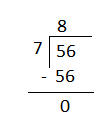
Question 9.
Gloria decided to make lemonade for her family. There are 8 people in her family. The pitcher will hold 24 glasses of lemonade. How many glasses can each person have?
Each person can have _______________ glasses.
Answer:
Given that Gloria decided to make lemonade for her family. There are 8 people in her family and the pitcher will hold 24 glasses of lemonade.
Divide 24 by 8. We get as the quotient.
Each person can have 3 glasses.
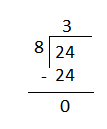
Question 10.
Susan, Marta, and Aisha have 5 hours to spend at the zoo. There are 40 different animals they want to see. During each hour at the zoo, how many animals should they plan to see?
They should plan to see ______________ different animals each hour.
Answer:
Given that Susan, Marta, and Aisha have 5 hours to spend at the zoo. There are 40 different animals they want to see.
So by dividing 40 by 5, we get to know the number of animals they can plan to see each hour.
40 ÷ 5 = 8.
They should plan to see 8 different animals each hour.
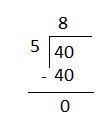
Question 11.
At baseball practice, 325 pitches were thrown to the players. If 5 players got the same number of pitches, how many pitches did each player get?
Each player got _____________ pitches.
Answer:
Given that at baseball practice, 325 pitches were thrown to the players. 5 players got the same number of pitches.
By dividing 325 by 5, we get 65.
Therefore each player will get 65 pitches.
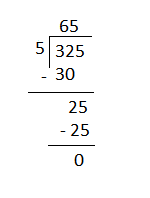
Question 12.
Taylor needs 612 more dollars to buy a plane ticket to visit his cousin in Australia. If he saves 9 dollars a day, how soon can he go to Australia?
He will have the rest of the money in ______________ days.
Answer:
Given that Taylor needs 612 more dollars to buy a plane ticket to visit his cousin in Australia. and he saves 9 dollars a day.
By dividing we get the required number of days, 612 ÷ 9 = 68
He will have the rest of the money in 68 days.
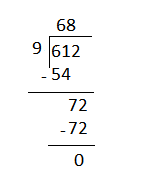
Question 13.
The bait shop ordered 136 fishing worms for their customers. The workers put them into 8 separate cups. How many worms are in each cup?
There are _______________ worms in each cup.
Answer:
Given that the bait shop ordered 136 fishing worms for their customers. The workers put them into 8 separate cups.
Dividing 136 by 8 gives 17.
Thus, there are 17 worms in each cup.
